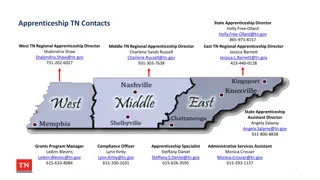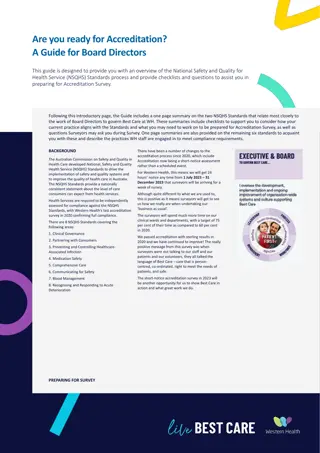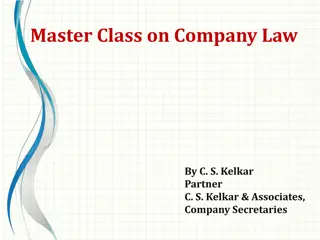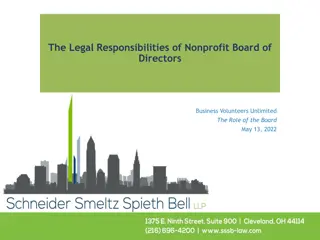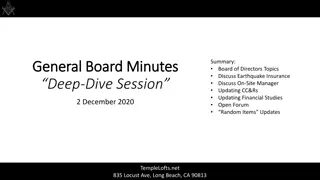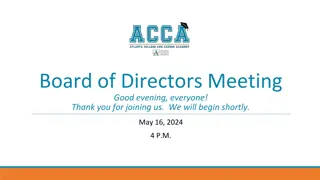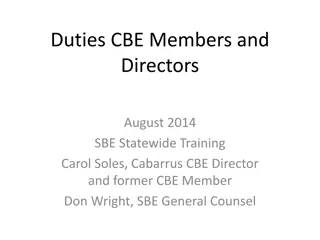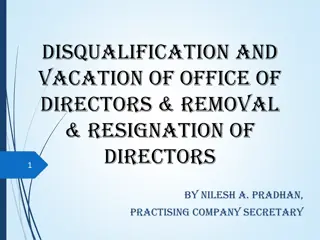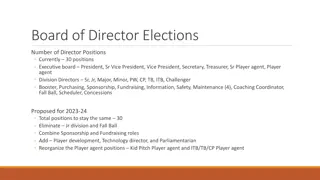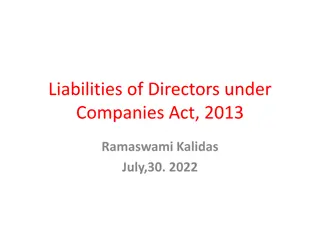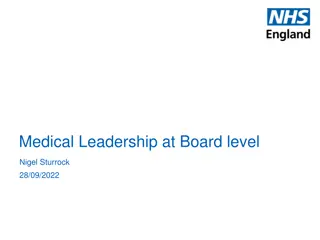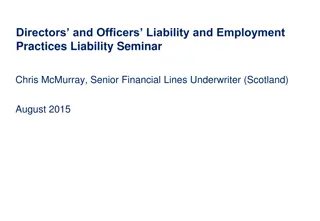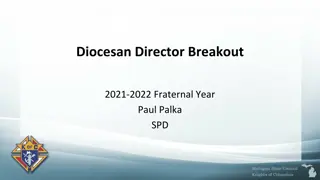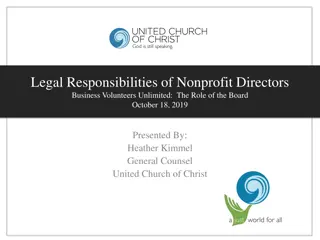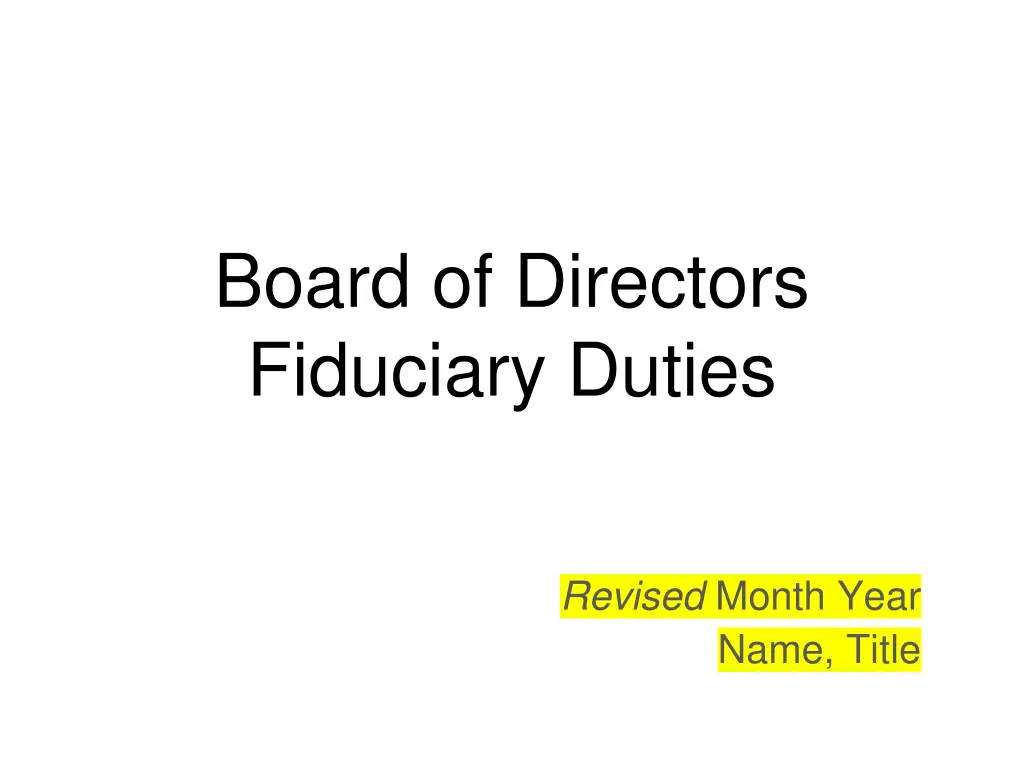
Understanding Board of Directors Fiduciary Duties
Learn about the essential fiduciary duties of board members, including Duty of Care, Duty of Loyalty, and Duty of Obedience. Explore the strategic versus tactical responsibilities of the board in overseeing organizational goals and missions.
Uploaded on | 0 Views
Download Presentation

Please find below an Image/Link to download the presentation.
The content on the website is provided AS IS for your information and personal use only. It may not be sold, licensed, or shared on other websites without obtaining consent from the author. If you encounter any issues during the download, it is possible that the publisher has removed the file from their server.
You are allowed to download the files provided on this website for personal or commercial use, subject to the condition that they are used lawfully. All files are the property of their respective owners.
The content on the website is provided AS IS for your information and personal use only. It may not be sold, licensed, or shared on other websites without obtaining consent from the author.
E N D
Presentation Transcript
Board of Directors Fiduciary Duties Revised Month Year Name, Title
The Board of Directors and its Duties The fundamental responsibility of a board of directors, whether it serves a publicly traded corporation, privately held business, or nonprofit organization, is to provide leadership and oversight so the organization can reach its goals and achieve its mission. Strategic planning and oversight, not tactical day-to-day operations. Members are expected to represent independent and diverse perspectives.
Board Member Fiduciary Duties There are three fiduciary duties: 1. Duty of Care Think: Am I acting in a strategic manner and not tactical? 1. Duty of Loyalty Think: Am I acting in a manner that is best for the organization? 1. Duty of Obedience Think: Am I acting in a manner consistent with the written documents of the Board? For example, the By-Laws, Confidentiality Agreement, etc.
Duty of Care The duty of care means that the board member actively participates, attends board meetings, is educated on the industry, provides strategic direction, and oversees management.
Strategic vs. Tactical Responsibilities Board Strategies Organizational/Operational Responsibilities Approving Strategic Plan Discussing internally on what areas need attention, who owns the focus areas, what steps necessary for success, writing the Plan, communicating and getting insight from the Board, holding staff accountable Approving Financial Statements, Budget, etc. Developing the budget with input from internal leadership, reviewing historical information, accurately reporting financial state, communicating and transparency to the Board, holding staff accountable Approving Quality, Compliance, Risk Management Plans and Dashboards, etc. Identifying areas that present organizational risk, identifying mitigation techniques and strategies, communicating to the Board, holding staff accountable
Duty of Loyalty The duty of loyalty requires the board member to operate in the interest of the organization and not to use the position to further their personal agenda or for personal gain. The duty of loyalty requires a duty of confidentiality. That is essentially a duty not to speak about board matters to non-board members or share board materials without non-board members unless authorized to do so.
Duty of Obedience The duty of obedience requires the board to know the state and federal laws and regulations that apply. This includes the regulations and guidance issued by the IRS. Obedience to governing documents requires: A deep understanding of the operating documents (by-laws, rules, board manuals) A clear understanding of the difference between the terms may and must contained in those documents That the board not act outside the scope of the organization s legal documents
The Boards Role in Compliance The Office of the Inspector General (OIG) expects board members to put forth meaningful effort to review the adequacy of compliance systems and functions. The United States Sentencing Commission s Guidelines require that an entity s governing authority shall be knowledgeable about the content and operation of the compliance and ethics program and shall exercise reasonable oversight with respect to the implementation and effectiveness of the compliance and ethics program. FOR FQHCs ONLY: HRSA requires the governing board to assure the center is operated in compliance with applicable Federal, State, and local laws and regulations. The board must have authority for establishing or adopting policies for the conduct of the Health Center.
Roles Within the Organization Edit this slide to reflect your organization s structure Compliance Leader Name Legal Leader Name Quality Leader Name Auditor (internal or external) Name Compliance Committee Members Departments represented
How Staff Work Together To Reduce Risk Edit this slide to align with your organization s process - this is a high level overview designed to instill confidence in your team How compliance risks are identified How compliance risks are investigated How appropriate corrective actions and decision making is implemented How communication happens between various functions
Information To Expect Regarding Compliance Edit this slide to align with your organization s bylaws Annually Insert information the board can expect to receive annually Quarterly Insert information board can expect to receive quarterly As Needed Updates on previously mentioned areas Information shared could include: reporting on internal and external investigations, serious issues raised in audits, hotline activity, allegations of material fraud or misconduct and exceptions to the organization s code of conduct or reimbursement policies.
Compliance Visibility and Confidence MedTrainer s all-in-one workforce compliance platform combines learning, compliance, and credentialing to give you and your board peace of mind. Real-time reports you can customize Incident report data and trends Comprehensive policy management Electronic document signing And so much more! Request a demo now!


